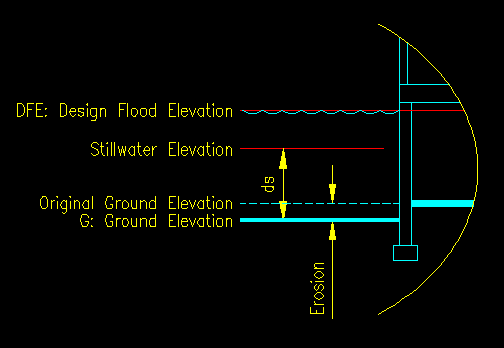| Overview |
| Definitions |
| Hydrostatic Loads |
| Hydrodynamic Loads |
| Breaking Wave Loads |
| Impact Loads |
| Example Problems |
|
References |
| Report Errors or Make Suggestions |
Section 6.2
Definitions
Last Revised: 11/04/2014
ASCE 7-05 and the FEMA Coastal Construction Manual (CCM) use similar, though different, definitions and terminology. As this text looks primarily at ASCE 7-05 with supplemental clarification from the CCM we will focus primarily on those definitions. See ASCE 7-05 for a more complete list of definitions. The ones presented here are those that are specifically needed for the calculations.
Base Flood Elevation, BFE: This definition is the same in both references. This value comes from a FIRM or similar hydrologic study. The elevation is associated with a flood that has a 1% probability of being equaled or exceeded in a given year. It also includes wave heights in addition to stillwater depths. This is the most critical reference value in the design process! This number must be correct for all other calculations to be right.
Design Flood Elevation, DFE: This is the BFE from the FIRM or an elevation designated on a flood hazard map adopted by the community in which the project resides. The DFE in the CCM is this value plus freeboard required by the building official and is used to specify the minimum elevation of the bottom of the lower most floor and it's supporting beams. So... be aware that this term is used differently between the two references.
Ground Elevation, G: This is the elevation at the base of the structure, accounting for erosion during the flood. It does not account for localized scour. In the CCM this term is "GS" which equals ground level before elevation less the erosion.
Stillwater Depth, ds: This is the steady state water depth not accounting for breaking waves. The stillwater depth is computed using ASCE 7-05 equation 5-3.
Stillwater Elevation: This equals the ground elevation, G, plus the stillwater depth, ds.
Figure 6.2.1
Elevation Definitions

Design Flood Velocity, V: This is the average velocity of the water (fps). The CCM states: "The estimation of design flood velocities in coastal flood hazard areas is subject to considerable uncertainty." This can also be said about riverine flooding as well. The ASCE 7-05 commentary (C5.4.3) suggests that information regarding velocities can be obtained from "local, state and federal government agencies and consulting engineers specializing in coastal engineering, stream hydrology, or hydraulics".
In lieu of better information, the commentary presents equations for maximum and minimum average velocities from the CCM. These are presented as ASCE 7-05 equations C5-1 and C5-2. The CCM recommends that you consider flood zone, topography and slope, distance from the source of flooding and proximity to other buildings or obstructions when deciding where in the range of possible velocities that you chose to select the design flood velocity for your project. It is best to be conservative.
Velocity has a direction component as well. You should be aware that, in coastal flooding, the direction may change during a flooding event. Due consideration for all possible flow directions should be considered when determining the loads on your structure.
It is highly recommended that you read discussion in section 11.6.6 of the CCM on this subject.
Unit Weight of Water, gw: ASCE 7-05 uses 62.4 pcf for the unit weight of fresh water and 64.0 pcf as the unit weight of salt water.